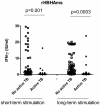Methylated HBHA produced in M. smegmatis discriminates between active and non-active tuberculosis disease among RD1-responders
- PMID: 21479248
- PMCID: PMC3066236
- DOI: 10.1371/journal.pone.0018315
Methylated HBHA produced in M. smegmatis discriminates between active and non-active tuberculosis disease among RD1-responders
Abstract
Background: A challenge in tuberculosis (TB) research is to develop a new immunological test that can help distinguish, among subjects responsive to QuantiFERON TB Gold In tube (QFT-IT), those who are able to control Mtb replication (remote LTBI, recent infection and past TB) from those who cannot (active TB disease). IFN-γ response to the Heparin-binding-hemagglutinin (HBHA) of Mtb has been associated with LTBI, but the cumbersome procedures of purifying the methylated and immunological active form of the protein from Mtb or M. bovis Bacillus Calmette et Guerin (BCG) have prevented its implementation in a diagnostic test. Therefore, the aim of the present study was to evaluate the IFN-γ response to methylated HBHA of Mtb produced in M. smegmatis (rHBHAms) in individuals at different stages of TB who scored positive to QFT-IT.
Methodology/principal findings: 87 individuals at different stages of TB who scored positive to QFT-IT were selected. IFN-γ response to in vitro whole blood stimulation with rHBHAms was evaluated by short-term and long-term tests and detected by ELISA or flow cytometry. We demonstrated that the IFN-γ response to rHBHAms is mediated by CD4(+) T-cells with an effector-memory phenotype. This response, evaluated by short-term-tests, is significantly lower in active TB than in remote LTBI (p = 0.0010) and past TB (p = 0.0152). These results were confirmed by long-term tests. The qualitative data confirmed that IFN-γ responses higher than the cut-off point identified by ROC analysis are associated with the status of non-active disease.
Conclusions: In this study we show that the T-cell response to a recombinant and methylated HBHA of Mtb produced in M. smegmatis is useful to discriminate between active and non-active TB disease among those responsive to QFT-IT in a whole blood system. Further studies are needed to improve the accuracy of the assay.
Conflict of interest statement
Figures






Similar articles
-
Involvement of methylated HBHA expressed from Mycobacterium smegmatis in an IFN-γ release assay to aid discrimination between latent infection and active tuberculosis in BCG-vaccinated populations.Eur J Clin Microbiol Infect Dis. 2017 Aug;36(8):1415-1423. doi: 10.1007/s10096-017-2948-1. Epub 2017 Apr 20. Eur J Clin Microbiol Infect Dis. 2017. PMID: 28429162
-
HBHA induces IL-10 from CD4+ T cells in patients with active tuberculosis but IFN-γ and IL-17 from individuals with Mycobacterium tuberculosis infection.Front Immunol. 2024 Aug 27;15:1422700. doi: 10.3389/fimmu.2024.1422700. eCollection 2024. Front Immunol. 2024. PMID: 39257584 Free PMC article.
-
[Evolution of IGRA researches].Kekkaku. 2008 Sep;83(9):641-52. Kekkaku. 2008. PMID: 18979999 Review. Japanese.
-
New tools for detecting latent tuberculosis infection: evaluation of RD1-specific long-term response.BMC Infect Dis. 2009 Nov 21;9:182. doi: 10.1186/1471-2334-9-182. BMC Infect Dis. 2009. PMID: 19930588 Free PMC article.
-
[Characteristics of a diagnostic method for tuberculosis infection based on whole blood interferon-gamma assay].Kekkaku. 2006 Nov;81(11):681-6. Kekkaku. 2006. PMID: 17154047 Review. Japanese.
Cited by
-
Measurement of phenotype and absolute number of circulating heparin-binding hemagglutinin, ESAT-6 and CFP-10, and purified protein derivative antigen-specific CD4 T cells can discriminate active from latent tuberculosis infection.Clin Vaccine Immunol. 2015 Feb;22(2):200-12. doi: 10.1128/CVI.00607-14. Epub 2014 Dec 17. Clin Vaccine Immunol. 2015. PMID: 25520147 Free PMC article.
-
Correlation of mycobacterium tuberculosis specific and non-specific quantitative Th1 T-cell responses with bacillary load in a high burden setting.PLoS One. 2012;7(5):e37436. doi: 10.1371/journal.pone.0037436. Epub 2012 May 22. PLoS One. 2012. PMID: 22629395 Free PMC article.
-
Contribution of a heparin-binding haemagglutinin interferon-gamma release assay to the detection of Mycobacterium tuberculosis infection in HIV-infected patients: comparison with the tuberculin skin test and the QuantiFERON-TB Gold In-tube.BMC Infect Dis. 2015 Feb 14;15:59. doi: 10.1186/s12879-015-0796-0. BMC Infect Dis. 2015. PMID: 25886172 Free PMC article.
-
Added Value of Long-Term Cytokine Release Assays to Detect Mycobacterium tuberculosis Infection in HIV-Infected Subjects in Uganda.J Acquir Immune Defic Syndr. 2016 Jul 1;72(3):344-52. doi: 10.1097/QAI.0000000000000980. J Acquir Immune Defic Syndr. 2016. PMID: 27306506 Free PMC article.
-
Two-Hit in vitro T-Cell Stimulation Detects Mycobacterium tuberculosis Infection in QuantiFERON Negative Tuberculosis Patients and Healthy Contacts From Ghana.Front Immunol. 2019 Jul 3;10:1518. doi: 10.3389/fimmu.2019.01518. eCollection 2019. Front Immunol. 2019. PMID: 31333654 Free PMC article. Clinical Trial.
References
-
- World Health Organization. Global Tuberculosis Control. Surveillance, Planning, Financing. 2010. ( www.who.int/tb/publications/global_report/en/). Accessed 2011 March 8.
-
- Pai M. Spectrum of latent tuberculosis - existing tests cannot resolve the underlying phenotypes. Nat Rev Microbiol. 2010;8:242. - PubMed
-
- Mack U, Migliori GB, Sester M, Rieder HL, Ehlers S, et al. LTBI: latent tuberculosis infection or lasting immune responses to M. tuberculosis? A TBNET consensus statement. Eur Respir J. 2009;33:956–973. - PubMed
-
- Solovic I, Sester M, Gomez-Reino JJ, Rieder HL, Ehlers S, et al. The risk of tuberculosis related to tumour necrosis factor antagonist therapies: a TBNET consensus statement. Eur Respir J. 2010;36:1185–1206. - PubMed
Publication types
MeSH terms
Substances
LinkOut - more resources
Full Text Sources
Other Literature Sources
Medical
Research Materials
Miscellaneous

